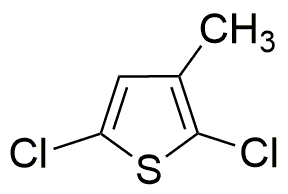2,5-Dichloro-3-methylthiophene is widely utilized in research focused on:
- Agricultural Chemistry: This compound serves as a key intermediate in the synthesis of agrochemicals, particularly fungicides and herbicides, helping to protect crops from pests and diseases.
- Pharmaceutical Development: It is used in the development of various pharmaceuticals, contributing to the creation of new drugs that target specific diseases, enhancing therapeutic options for patients.
- Material Science: The compound is explored in the production of specialty polymers and materials, providing unique properties such as improved thermal stability and chemical resistance.
- Organic Synthesis: As a versatile building block, it aids chemists in creating complex organic molecules, streamlining the synthesis process in laboratories.
- Environmental Monitoring: Its derivatives are utilized in analytical chemistry for detecting environmental pollutants, helping industries comply with safety regulations and protect ecosystems.
General Information
Properties
Safety and Regulations
Applications
2,5-Dichloro-3-methylthiophene is widely utilized in research focused on:
- Agricultural Chemistry: This compound serves as a key intermediate in the synthesis of agrochemicals, particularly fungicides and herbicides, helping to protect crops from pests and diseases.
- Pharmaceutical Development: It is used in the development of various pharmaceuticals, contributing to the creation of new drugs that target specific diseases, enhancing therapeutic options for patients.
- Material Science: The compound is explored in the production of specialty polymers and materials, providing unique properties such as improved thermal stability and chemical resistance.
- Organic Synthesis: As a versatile building block, it aids chemists in creating complex organic molecules, streamlining the synthesis process in laboratories.
- Environmental Monitoring: Its derivatives are utilized in analytical chemistry for detecting environmental pollutants, helping industries comply with safety regulations and protect ecosystems.
Documents
Safety Data Sheets (SDS)
The SDS provides comprehensive safety information on handling, storage, and disposal of the product.
Product Specification (PS)
The PS provides a comprehensive breakdown of the product’s properties, including chemical composition, physical state, purity, and storage requirements. It also details acceptable quality ranges and the product's intended applications.
Certificates of Analysis (COA)
Search for Certificates of Analysis (COA) by entering the products Lot Number. Lot and Batch Numbers can be found on a product’s label following the words ‘Lot’ or ‘Batch’.
*Catalog Number
*Lot Number
Certificates Of Origin (COO)
This COO confirms the country where the product was manufactured, and also details the materials and components used in it and whether it is derived from natural, synthetic, or other specific sources. This certificate may be required for customs, trade, and regulatory compliance.
*Catalog Number
*Lot Number
Safety Data Sheets (SDS)
The SDS provides comprehensive safety information on handling, storage, and disposal of the product.
DownloadProduct Specification (PS)
The PS provides a comprehensive breakdown of the product’s properties, including chemical composition, physical state, purity, and storage requirements. It also details acceptable quality ranges and the product's intended applications.
DownloadCertificates of Analysis (COA)
Search for Certificates of Analysis (COA) by entering the products Lot Number. Lot and Batch Numbers can be found on a product’s label following the words ‘Lot’ or ‘Batch’.
*Catalog Number
*Lot Number
Certificates Of Origin (COO)
This COO confirms the country where the product was manufactured, and also details the materials and components used in it and whether it is derived from natural, synthetic, or other specific sources. This certificate may be required for customs, trade, and regulatory compliance.


